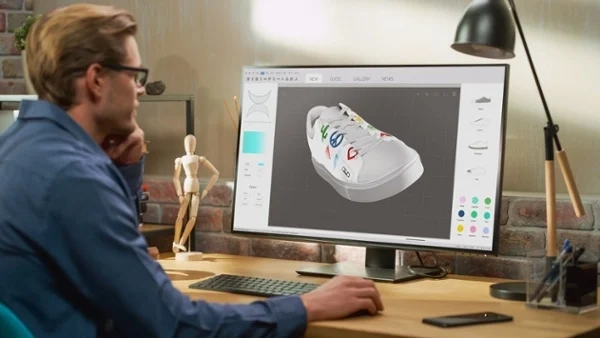How 3D Asset Management Helps Streamline Production Processes
In our previous post, 3D Asset Values: The Benefits of Implementing a DAM System, we explored key features of Digital Asset Management (DAM) systems...
3 min read
 Matt Astarita, Product Manager at Hyland's Nuxeo
:
Jun 27, 2023
Matt Astarita, Product Manager at Hyland's Nuxeo
:
Jun 27, 2023

Are you sure you're ready to scale the creation and use of 3D assets across your organization?
You've already transitioned from a physical to a digital product creation process and chosen the best technologies for your Materials, Product Lifecycle, and 3D modeling. However, you most likely need a critical component of your stack in order to scale.
Through proper 3D asset management and distribution, you'll understand how to improve your supply chain and production process and deliver exceptional brand experiences to consumers. This post and another coming up will focus on four primary topics:
Digital Asset Management (DAM) is the process of centrally organizing, storing, and distributing digital assets. Because 3D models are increasingly used for virtual fashion shows, product design, and e-commerce, DAM for 3D assets is especially important for the fashion industry. A well-organized central hub is critical when scaling, and the content volume rapidly increases.
Fashion organizations can effortlessly search, locate, and access the assets they need with proper access control by using a DAM system, ensuring that everyone uses the most up-to-date versions.
The DAM system allows you to securely and efficiently share assets with authorized team members or external partners.
Furthermore, DAM systems for 3D assets include version control, which is especially useful for collaborative projects. This enables team members to track changes to 3D assets over time and, if necessary, revert to previous versions, ensuring that everyone is working with the correct version of each asset.
It helps to improve collaboration, streamline workflows, and ensure that everyone in the organization has access to the assets required to create high-quality fashion content. From the same DAM, Fashion companies can distribute their 3D assets to various channels such as virtual fashion shows, product design, and e-commerce platforms.
With a simple search of the internet, you can find successful uses of DAM by fashion companies such as:
Adidas has been using a DAM system to store and distribute 3D assets across its global teams. This has resulted in more efficient and faster workflows, allowing the company to design, create, and launch products more quickly.
Tommy Hilfiger uses a DAM system to manage their product images and 3D assets. This allowed them to efficiently distribute the assets to their e-commerce platforms, providing customers with a more consistent and cohesive online shopping experience.
Even with an understanding of the critical features of DAM for 3D asset management, you may still be struggling to keep your content organized and confused about how to fix it.
A fashion company can organize its assets into folders such as "clothing designs," "accessories," or "footwear." Subfolders can be created within each folder based on the project or department. Subfolders can be created in the "clothing designs" folder for each season or clothing line, such as "Spring/Summer 2023" or "Holiday Collection 2023."
This also allows you to quickly find and reuse your 3D assets, saving you a lot of time and effort throughout a project or campaign.
It's critical to use descriptive names that adhere to a consistent format, including the project name, asset type, and version number in the file name. For example, if you're working on a clothing design project, you could name your files "ProjectName ClothingDesigns v01," "ProjectName ClothingDesigns v02," and so on. This lets you quickly identify the specific file version you require while avoiding confusion caused by similar file names.
Metadata includes information like the asset's name, creation date, author, and project name. Additionally, you can use keywords and tags to make it easier to locate your assets later. This can be done manually or with the help of AI tools like Nuxeo Insight.
Assume you own a fashion company and want to store your 3D clothing designs in the Hyland Nuxeo DAM. You could create a schema that includes details such as the item's name, season, collection, color, materials, and category (like "dresses" or "jackets"). With this schema, you can quickly locate all the dresses from a specific season or the jackets from a specific category.
The beauty of this approach is that you can make the schema as detailed as you require to support your users and business needs. The goal is to have the most organized content possible to allow your users to easily find what they need to create, modify, validate, or distribute assets.
Stay tuned for more insightful posts on effectively creating, managing, and distributing 3D assets across your organization.
About the Author
Genus guest blogger Matt Astarita specializes in Product Management at Hyland's Nuxeo. Matt is passionate about creating digital products that drive innovation and add value to people's lives. Throughout his career, he has developed a deep understanding of the product development process and continues to hone his skills in identifying market needs, conducting market research, and creating strategic product roadmaps. Connect with Matt on LinkedIn!
Get more useful content, expert tech tips, and timely articles delivered to your inbox ~ Subscribe to Genus Insights!

In our previous post, 3D Asset Values: The Benefits of Implementing a DAM System, we explored key features of Digital Asset Management (DAM) systems...

A Product Asset Management solution is the next generation of Digital Asset Management (DAM). Product Asset Management connects content, data, and...

This is Part 2 in a 3-part series focusing on working with Nuxeo Cloud Customer Console in sandbox environments. In this part, we take a look at...